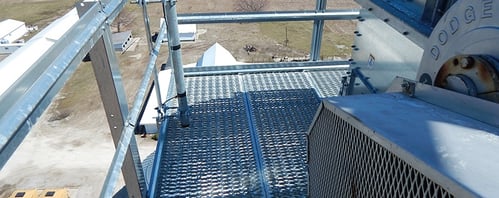Slips, trips, and falls in the workplace are no laughing matter. In fact, they account for more than 225,000 injuries a year. And 70% of these incidents occur on level surfaces with falls from less than four feet above ground!
 The higher up from ground level you go, the greater the danger. Falls from elevated areas, such as catwalks, scaffolds and fixed ladders, can be disabling—or even fatal. For 2014, the U.S. Bureau of Labor Statistics reported 793 fatal injuries at work from slips, trips and falls, a 10 percent increase from 2013.
The higher up from ground level you go, the greater the danger. Falls from elevated areas, such as catwalks, scaffolds and fixed ladders, can be disabling—or even fatal. For 2014, the U.S. Bureau of Labor Statistics reported 793 fatal injuries at work from slips, trips and falls, a 10 percent increase from 2013.
When it comes to the wide variety of surfaces on the farm, OSHA requires that employers meet specific regulatory standards. It is your responsibility to be aware of these requirements and to always work with the utmost caution—for your own safety and the co-workers around you.
Below are some commonsense, farm-safety tips to help you avoid slips, trips and falls.
Remain aware of surface conditions, and wear appropriate footwear.
Watch out for everyday hazards that include mud, liquids and other watery surfaces or materials. Depending on the surface conditions you're walking on, wear the right footwear for the job, and walk carefully considering those conditions.
Use grips, avoid shortcuts, clear aisles and stairways of obstructions and use handrails.
Take extra care when using stairs, mounting and dismounting machinery and walking through narrow aisles. Clear them of obstructions and other tripping hazards, and use handrails, where applicable.
Cover holes or barricade them.
All holes or floor openings should have barricades—or remain covered—when not in use.
Look for guardrails.
Guardrails save lives. Make sure they're in place. Don't risk working without them. Talk to your supervisor, if an area needs them.
Familiarize yourself with ladder cages.
Check that ladder cages and scaffolds you may need to use have been thoroughly inspected recently, and avoid using them during adverse weather conditions.
Lifelines are your lifeline.
Because lifelines can prevent serious injury, OSHA has established standards to ensure their effectiveness. Lifelines must be used on bucket-truck baskets, raised platforms more than twenty feet tall and any scaffold without guardrails. Lifelines also must be anchored securely above the walking surface in use—and not attached to the scaffolding or ladder. And finally, a lifeline must be taken out of service once it has protected someone from a fall. It must then be replaced with a new lifeline for the next person.
Whether it's soil, concrete or metal, you must take care when you walk on all surfaces, high and low. Keep your feet on the ground, and follow these safe practices.
Moreover, don't settle for hazardous working conditions—describe the hazards to your supervisor or the safety director. You should be confident you'll have a slip-, trip- and fall-free day.



